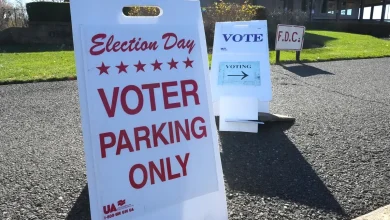Snowstorm to wreak havoc on weekend travel in Midwest. See forecast.

The trip home from Thanksgiving for millions of travelers in the central U.S. will be disrupted by a “significant winter storm,” forecasters said.
What is the polar vortex? How it can impact snow, freezes in the U.S.
The polar vortex is a large area of circulating cold air above the North Pole. Strong winds keep it contained, but when it weakens, it can wobble and stretch.
The trip home from Thanksgiving for millions of travelers in the central U.S. will be disrupted by a “significant winter storm,” National Weather Service forecasters said.
“A large area of accumulating snow will spread from the Rockies and High Plains to much of the Midwest throughout the weekend,” said Alex Sosnowski, AccuWeather senior meteorologist in an online forecast. “Motorists and airline passengers alike should anticipate substantial travel delays.”
The National Weather Service said that heavy snowfall accumulating to 6 inches to 12 inches or more “will create dangerous travel for many areas, including Des Moines, Chicago, and Milwaukee.”
Saturday, Nov. 29 the worst for travel
“The period from Saturday (Nov. 29) to Saturday night is likely to be the worst for travel, considering that the snowstorm will be in progress over such a large area,” AccuWeather director of forecasting operations Carl Erickson said.
By Saturday, Nov. 29, accumulating snow is likely to be falling along a 1,200-mile-long swath from west of Denver to east of Detroit, AccuWeather said.
Snow is forecast to fall during the college football game between Ohio State and Michigan in Ann Arbor Saturday afternoon, the weather service said, though the heaviest snow will likely hold off until after the game.
Saturday night, the “wintry mess will spread a bit farther east into the Ohio Valley and eastern Great Lakes,” Weather.com predicted in an online forecast.
Southern storms
While the north-central U.S. deals with snow, heavy rain and potentially severe thunderstorms are forecast to rattle the south-central states on Saturday Nov. 29.
“Thunderstorms with heavy rain, and possibly some severe weather, will rumble across the South from Oklahoma and Texas to the middle and lower Mississippi Valley,” Weather.com meteorologists said. “This could lead to local flash flooding and flight delays at both Dallas-Ft. Worth and Houston.”
The Storm Prediction Center said that “perhaps even a tornado” is possible.
Storms head east Sunday, Nov. 30
By Sunday, Nov 30, a mixture of snow, sleet and rain is forecast for the northern portions of the Appalachians and the areas surrounding lakes Erie and Ontario, AccuWeather’s Sosnowski said. This includes the northern and western parts of Pennsylvania, as well as central New York and northwestern New England.
Along the East Coast, particularly along the Interstate 95 urban corridor, precipitation will be in the form of rain, Weather.com said. “Regardless, this could lead to significant flight delays in the major East Coast hubs.”
Snowfall tracker: See how much snow fell near you
Wondering how much snow has fallen near you? USA TODAY’s detailed map below lets you explore snowfall accumulation over the past 24, 48, and 72 hours. You can also check seasonal totals starting from Oct. 1.
Updated multiple times daily, this tool provides the latest snowfall data. Toggle between timeframes to see how snowfall is adding up in your area.
United States weather alerts
The interactive map below shows all of the weather alerts (warnings, watches and advisories) currently in effect from the National Weather Service. This map is updated every 15 minutes.
Preparing your home for snow, cold
Well before winter storm advisories begin, make sure you’ve taken steps to ensure your home and family is fortified against the cold, advised Kari Goelz, emergency management director for Grand Forks County, North Dakota. “Prepare for the worst day,” for example, a winter storm so severe that you lose power and can’t leave your home for a week.
Here are some tips to stay safe when it gets cold:
- Make sure your home can be safely heated.
- Always have supplies on hand for up to 10 days, in case you’re without power or can’t leave home, including non-perishable food, medicines, water and pet food.
- Have your furnace checked.
- Is your snow blower working?
- Keep out the cold with caulking, and weather stripping, and check to see if repairs are needed.
- Check batteries in smoke alarms and carbon monoxide detectors.
- Are your water pipes protected? Some people insulate their pipes, some wrap with heat tape. Others let their faucets drip a little to prevent frozen pipes.
- Use battery-powered lights and flashlights, and have back-up batteries.
Preparing your car or truck for snow, cold
- During winter storm and blizzard conditions, stay off the road, unless absolutely necessary, Goelz said.
- Check the weather before traveling and make sure your cell phone battery is charged.
- If you have to drive, slow down and be sure your headlights are on.
- Have a safety kit inside the car in case you get stranded, with blankets, water, non-perishable foods that are high in energy and medication for up to three days.
- Have enough blankets, clothes and supplies for everyone in your car.
- If you have to travel, make sure someone knows where you are going to be and when you expect to arrive.





